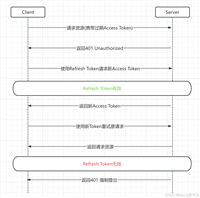1. 前 言
在推送镜像文件到镜像仓库时,我们往往是在镜像文件所在的那个主机上,以 root 用户的权限,执行 docker push 命令,完成镜像推送的工作。
但有这么一种令人匪夷所思的人,他直接打一个离线的镜像包(docker save tomcat:latest > tomcat-892148dsadg-v1.tar)出来,比如 tomcat-892148dsadg-v1.tar ,然后通过邮件或者其它通讯工具发给你,让你推送到镜像仓库。
这时,你怎么搞?直接通过 shell 指令操作,可行吗?当然可以,只要在有 docker 环境的服务器上,
以 root 权限的用户执行下面 5 步就能完成:
- rz 命令,上传 tar 包到服务器上
- docker load -i xxxx.tar ,加载镜像文件
- docker login harbor仓库地址 -u 用户名 -p 密码 ,登录 harbor 仓库
- docker tag xxxx.tar harbor仓库地址/命名空间/xxxxx.tar,重新打标签
- docker push harbor仓库地址/命名空间/xxxxx.tar,推送镜像到 harbor 仓库
上面的方式,看着是很清晰地解决了问题,但一般来说,开发人员很少能直接操控服务器,更别提拿到 root 用户,在一些权限管控严格的企业,这种方式想想就好了,或者让运维来。
那还有其它方式吗?当然!那就直接用 java 操作 docker 命令实现离线的 tar包 推送至 harbor 仓库吧!
2. 编写工具类
2.1 引入依赖包
- 在 pom.xml 文件中引入下面的两个依赖
<dependency>
<groupid>com.github.docker-java</groupid>
<artifactid>docker-java</artifactid>
<version>3.2.13</version>
</dependency>
<dependency>
<groupid>com.github.docker-java</groupid>
<artifactid>docker-java-transport-httpclient5</artifactid>
<version>3.2.13</version>
</dependency>
2.2 使用当前服务器的docker环境推送镜像
- application.properties 配置文件
harbor.username=harbor harbor.password=harbor123!
- 工具类
import com.github.dockerjava.api.dockerclient;
import com.github.dockerjava.api.model.authconfig;
import com.github.dockerjava.api.model.image;
import com.github.dockerjava.core.defaultdockerclientconfig;
import com.github.dockerjava.core.dockerclientimpl;
import com.github.dockerjava.httpclient5.apachedockerhttpclient;
import com.github.dockerjava.transport.dockerhttpclient;
import lombok.extern.slf4j.slf4j;
import org.springframework.beans.factory.annotation.value;
import org.springframework.stereotype.service;
import java.io.file;
import java.io.fileinputstream;
import java.io.ioexception;
import java.io.inputstream;
import java.time.duration;
import java.util.list;
/**
* @author yuhuofei
* @version 1.0
* @description 镜像上传工具类
* @date 2022/6/13 21:19
*/
@service
@slf4j
public class dockerutils {
@value("${harbor.username}")
private string harborusername;
@value("${harbor.password}")
private string harborpassword;
/**
* 获取dockerclient对象
*/
public dockerclient getdockerclient() {
//创建defaultdockerclientconfig(当前服务器的默认配置)
defaultdockerclientconfig config = defaultdockerclientconfig.createdefaultconfigbuilder().build();
//创建dockerhttpclient
dockerhttpclient httpclient = new apachedockerhttpclient.builder()
.dockerhost(config.getdockerhost())
.maxconnections(100)
.connectiontimeout(duration.ofseconds(30))
.responsetimeout(duration.ofseconds(45))
.build();
//创建dockerclient
return dockerclientimpl.getinstance(config, httpclient);
}
/**
* @param file 镜像文件
* @param imagename 镜像名称,格式最好是:镜像名-镜像id-版本号.tar
* @param harborloginurl harbor仓库地址
* @param imageid 镜像id
* @param tag 版本号
*/
public void uploadimage(file file, string imagename, string harborloginurl, string imageid, string tag) {
log.info("上传镜像文件时,传递的参数:{},{},{},{},{}", file.getabsolutepath(), imagename, harborloginurl, imageid, tag);
try (inputstream inputstream = new fileinputstream(file)) {
dockerclient dockerclient = getdockerclient();
//harbor登录信息
authconfig autoconfig = new authconfig().withregistryaddress(harborloginurl).withusername(harborusername).withpassword(harborpassword);
//加载镜像
log.info("====开始加载镜像====,{}", inputstream);
dockerclient.loadimagecmd(inputstream).exec();
//获取加载镜像的名称,如果根据镜像名称去匹配,有可能重复,所以用镜像id去匹配
string uploadimagename = "";
list<image> list = dockerclient.listimagescmd().exec();
for (image image : list) {
if (image.getid().contains(imageid)) {
uploadimagename = image.getrepotags()[0];
}
}
//给镜像打上tag
log.info("原始镜像名:{},要修改的镜像名:{}", uploadimagename, imagename);
dockerclient.tagimagecmd(uploadimagename, imagename, tag).exec();
//推送镜像至镜像仓库
dockerclient.pushimagecmd(imagename).withauthconfig(autoconfig).start().awaitcompletion();
//push成功后,删除本地加载的镜像
dockerclient.removeimagecmd(imagename).exec();
dockerclient.removeimagecmd(uploadimagename).exec();
} catch (interruptedexception exception) {
throw new baseexception("推送镜像到镜像仓库异常:{}", exception);
} catch (ioexception e) {
throw new baseexception("镜像文件流处理异常");
}
}
}
2.2 使用指定服务器的docker环境推送镜像
- application.properties 文件的配置
docker.server.url=tcp://xxxxxx:2376 docker.cert.path=/home/user/.docker/certs api.version=1.41 registry.url=https://index.docker.io/v1/ registry.username=docker registry.password=docker123! registry.email=xxxxxxx@qq.com harbor.username=harbor harbor.password=harbor123!
- 工具类
import com.github.dockerjava.api.dockerclient;
import com.github.dockerjava.api.model.authconfig;
import com.github.dockerjava.api.model.image;
import com.github.dockerjava.core.defaultdockerclientconfig;
import com.github.dockerjava.core.dockerclientimpl;
import com.github.dockerjava.httpclient5.apachedockerhttpclient;
import com.github.dockerjava.transport.dockerhttpclient;
import lombok.extern.slf4j.slf4j;
import org.springframework.beans.factory.annotation.value;
import org.springframework.stereotype.service;
import java.io.file;
import java.io.fileinputstream;
import java.io.ioexception;
import java.io.inputstream;
import java.time.duration;
import java.util.list;
/**
* @author yuhuofei
* @version 1.0
* @description 镜像上传工具类
* @date 2022/6/13 21:19
*/
@service
@slf4j
public class dockerutils {
@value("${docker.server.url}")
private string dockerserverurl;
@value("${docker.cert.path}")
private string dcokercertpath;
@value("${registry.user}")
private string registryuser;
@value("${registry.pass}")
private string registrypass;
@value("${registry.mail}")
private string registrymail;
@value("${registry.url}")
private string registryurl;
//harbor仓库登录用户名
@value("${harbor.username}")
private string harborusername;
//harbor仓库登录密码
@value("${harbor.password}")
private string harborpassword;
/**
* 获取dockerclient对象
*/
public dockerclient getdockerclient() {
//创建defaultdockerclientconfig(指定docker服务器的配置)
dockerclientconfig config = defaultdockerclientconfig.createdefaultconfigbuilder()
.withdockerhost(dockerserverurl)
.withdockertlsverify(true)
.withdockercertpath(dcokercertpath)
.withregistryusername(registryuser)
.withregistrypassword(registrypass)
.withregistryemail(registrymail)
.withregistryurl(registryurl)
.build();
//创建dockerhttpclient
dockerhttpclient httpclient = new apachedockerhttpclient.builder()
.dockerhost(config.getdockerhost())
.maxconnections(100)
.connectiontimeout(duration.ofseconds(30))
.responsetimeout(duration.ofseconds(45))
.build();
//创建dockerclient
return dockerclientimpl.getinstance(config, httpclient);
}
/**
* @param file 镜像文件
* @param imagename 镜像名称,格式最好是:镜像名-镜像id-版本号.tar
* @param harborloginurl harbor仓库地址
* @param imageid 镜像id
* @param tag 版本号
*/
public void uploadimage(file file, string imagename, string harborloginurl, string imageid, string tag) {
log.info("上传镜像文件时,传递的参数:{},{},{},{},{}", file.getabsolutepath(), imagename, harborloginurl, imageid, tag);
try (inputstream inputstream = new fileinputstream(file)) {
dockerclient dockerclient = getdockerclient();
//harbor登录信息
authconfig autoconfig = new authconfig().withregistryaddress(harborloginurl).withusername(harborusername).withpassword(harborpassword);
//加载镜像
log.info("====开始加载镜像====,{}", inputstream);
dockerclient.loadimagecmd(inputstream).exec();
//获取加载镜像的名称,如果根据镜像名称去匹配,有可能重复,所以用镜像id去匹配
string uploadimagename = "";
list<image> list = dockerclient.listimagescmd().exec();
for (image image : list) {
if (image.getid().contains(imageid)) {
uploadimagename = image.getrepotags()[0];
}
}
//给镜像打上tag
log.info("原始镜像名:{},要修改的镜像名:{}", uploadimagename, imagename);
dockerclient.tagimagecmd(uploadimagename, imagename, tag).exec();
//推送镜像至镜像仓库
dockerclient.pushimagecmd(imagename).withauthconfig(autoconfig).start().awaitcompletion();
//push成功后,删除本地加载的镜像
dockerclient.removeimagecmd(imagename).exec();
dockerclient.removeimagecmd(uploadimagename).exec();
} catch (interruptedexception exception) {
throw new exception("推送镜像到镜像仓库异常:{}", exception);
} catch (ioexception e) {
throw new exception("镜像文件流处理异常");
}
}
}
3. 说 明
- 上述的 java 服务,不能部署在 docker 环境的容器内,需要部署在 docker 主机上,不然在容器中运行的 java 服务,是没法操作到主机上的 docker 命令的
- 上传 tar 包文件的前端内容省略
- 这里上传的 tar 包命名格式最好是:镜像名-镜像id-版本号.tar
- 打出来的 tar 包,大小最好不要超过 20 g
总结
以上为个人经验,希望能给大家一个参考,也希望大家多多支持代码网。







发表评论